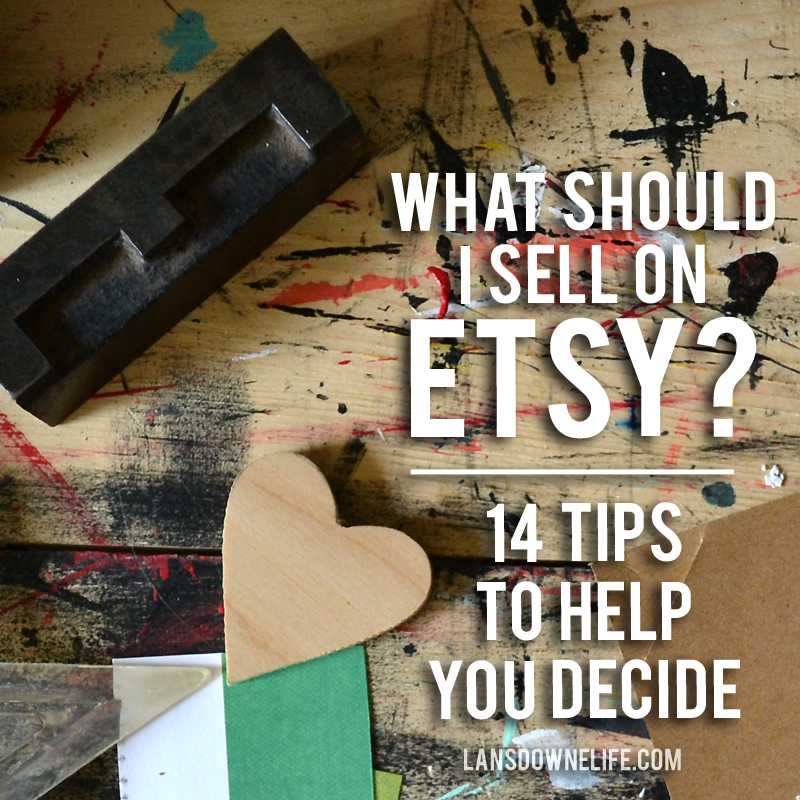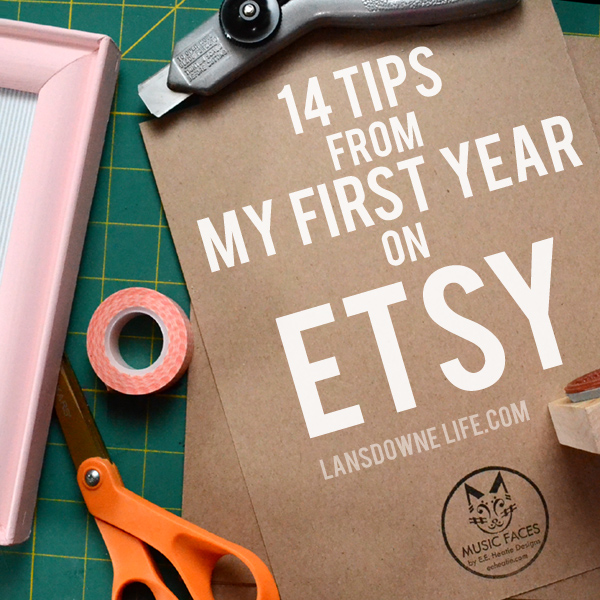
For years before starting my business, I had a deep-seated desire to make things and sell them. The only catch was I wasn’t sure what those things should be exactly. I’m a creative person, and I’ve made a lot of different things over the years. This blog documents that. Still, if you had asked me three years ago what would be in my future shop, I wouldn’t have been able to tell you.
There were certainly kernels of ideas, but it took a lot of thinking and a lot of trial and error to decide what I could sell and what people wanted to buy. And even since opening my shop, my offerings have evolved almost 100 percent as I’ve learned what works and what doesn’t. It’s an ongoing process.
So you’re crafty too, and you want to sell on Etsy. You’ve got ideas, but you’re not sure which idea is the right idea. If you are just getting into business, and you’re trying to develop your products, here are some points to consider.
1. Are you making something people want to pay for?
This is probably the most important question to answer. And it’s OK if the answer is “no.” Just because your craft doesn’t translate to a salable product doesn’t mean it’s not worth doing.
Ask a trusted friend or two what they think. Seek honest opinions rather than ego boosting. Don’t cloud your own judgement with too many opinions, though. In the end, trust yourself.
If the answer is still “no,” and your heart is set on starting a business, what can you do to tweak your idea to be more attractive to potential customers? (Experiment with different materials, get some help picking out trendier colors or patterns, add interesting details, etc.)
2. Do you enjoy making what you make?
It seems a bit silly to even ask this, but pretend this is going to be what you’re doing for the next 3-5 years. I like to sew, but I don’t think I would like to sew everyday, all the time. If you’re going to stick with it, you’ve got to find the thing that you can do over and over and over and over that still makes you happy.
3. Search to do research.
Take a look around Etsy. Are there similar products to yours already listed? How are yours different? Are they better than what is already there? Will they stand out? How many results do you get when you search? When you type your keywords in the search box, what phrases are displayed in the drop down box? Those are clues to what people are searching for and how it’s phrased. Use the clues.
4. Don’t invent a product.
Not to discourage anyone from being clever or creative, but online, people have to know your product exists so they can search for it.
Maybe you want to start selling fashion elbowpads. Or shoes for cats. Or even something not quite so ridiculous. That’s great! Maybe they’ll take off; who am I to judge? But you are going to be spending a massive amount of time and effort educating your customer about your product. People won’t get it. Confused customer = no bueno. It’s not that they won’t like it, but you’ll have to do a lot of explaining and “selling” before they realize they want/need it. And they may not stick around for your whole sales pitch.
On the other hand, let’s say you want to sell t-shirts. Everyone already understands what a t-shirt is. No need to explain. And people are searching Etsy for t-shirts. Get my drift?
(But hey, if you really believe you have a world-changing idea and the passion to back that up, just go for it. Don’t let me stop you!)
5. What are your start up costs?
Do you need tools or equipment you don’t own already? How about a camera or a sewing machine or computers or printers or software? Can you afford any/all of the things? Even if it’s only a few hundred dollars, it can be hard to spend money without any guarantee of sales. Don’t fret. Figure out the bare minimum of what you need to get started. Maybe you won’t be able to execute all of your ideas at first. Start small. Sell enough to fund the next step in your business. Build your business off your profits.
6. You need to make the same things over and over again.
I’m pretty sure I would have scoffed at this advice prior to opening my own shop. And who am I to stop you from doing things the hard way? But unless you are making high-end pieces, selling only one-of-a-kind items can be tough. Making the same thing over and over again comes with efficiencies. Certainly, you get better and faster at making things with more practice, but also:
- You take the product photos and write the description once. This works for made-to-order items and others with little variation. If it’s not clear, make sure you state that the item your customer will receive is not the exact item in the photo, but a duplicate.
- You know what the item weighs, how to package it, and what it costs to ship. You can estimate all day long, but the actual experience makes things a lot easier.
- You can set the item to auto-renew if it sells. Your total number of items in your shop doesn’t decrease. Someone else can buy the item again as soon as it’s relisted.
- Renewing listings is good for SEO. Sometimes Etsy listings are indexed by Google. But what if your one-of-a-kind item sells? If someone lands on that page through a Google search and the item is sold, it’s gone, and no one can buy it. If you have renewed the listing, the page your customer lands on is live, and they can buy your item.
Certainly you can have some variation with this; switch up the colors or fabrics or make other minor adjustments. Just remember to update your photos and descriptions to reflect the changes.
7. Is it worth your time?
How long does it take you to make something? Even if you are charging appropriately for the time you invest, can you make enough product to fill a shop? An Etsy storefront with only a handful of items won’t get you noticed by buyers.
8. Choose plentiful and reliable raw materials and supplies.
Are your raw materials and supplies easy to find at reasonable prices? Can you buy more when you run low? Craft stores are OK for some things (when taking advantage of sales and coupons!), but you will probably need to seek out some sources where you can buy in larger quantities at cheaper-than-retail prices. I promise this will lead you into endless Google searching, so be careful not to fall down the rabbit hole. If you are using rare, vintage, or found materials, make sure you have dependable sources and a large stock pile. Also, be conscious of the time you’re putting into research and sourcing.
9. Think about how to photograph the item.
Have you tried taking pictures of your items yet? Are they reflective? Are they big? Do you need models? How easy will it be for you to accomplish this? Photos are everything on Etsy. Assess your photography skills. Spend some time taking sample photos, and see what issues you run into. You might want re-think your items if the photography is too much of a project for you. (Or consider hiring out or bartering with a photographer!)
10. Do your items look good in photos?
Even with great photos, there’s a disconnect in online shopping. Etsy buyers can’t touch your item to see the time and care you put into creating it. Online shoppers are buying a photo and a promise that the actual item will be the same or better than what they see in the photo. Do your photos give them confidence to take that leap of faith with you?
11. Consider your profit margins.
Can you sell your items at reasonable prices while still valuing your own time? Price out your raw materials, Etsy listing and transaction fees, credit card fees, and shipping supply costs. Don’t forget you will be paying taxes on your profits! What’s left? If you ever plan to do wholesale, cut that figure in half. Can you still make a decent profit? There is no right or wrong answer to this, but be nice to yourself. Value the time you put into your craft. Don’t work for free or a pittance, even if it’s a “hobby.” (Pssst: A hobby is no longer a hobby if your intent is to make money.)
12. Don’t forget about shipping.
Shipping products is a big part of online selling, so consider it from the very beginning. How much do your items weigh? Pack one up, weigh it, and get an estimate for how much it might cost to ship. Is it reasonable? Would it be a deterrent to buyers? Are your items large? Can you ship via regular mail or will you need a special carrier?
What kind of shipping supplies will you need? How many types/sizes of envelopes or boxes will you need to stock? It’s easy to tie up a lot of money in shipping supplies that just sit there until you get a sale.
13. You never know what is going to sell until it does.
Ultimately, it’s all trial and error. No one really knows what will sell and what won’t. Most of the time, it’s hard to predict. Give an item a full year on Etsy before deciding it’s unsalable. I’ve had items listed for nine months before the right buyer came along. Twenty cents for four months is a minimal investment to keep an item in the shop, so unless it’s somehow hurting the look of your shop, just keep it up. Stick it in a “sale” category, if you must. It’s another item to bolster your total number of items.
14. Some things are going to sell better in person.
Maybe you own it at craft fairs, but Etsy seems intimidating. That’s OK. Etsy is a different animal with its own rules. There’s a lot of competition out there, and many items will be easier to sell when customers can touch and feel them in person. It’s OK not to play the Etsy game. Find a venue that works best for you, and stick with it.
Want to stay up-to-date with my shop? Sign up for my email list right here! >>
Get more tips about selling on Etsy >>










I’ve been reminded that patience is needed when opening an etsy shop! That has never been a strong quality for me! However, I did read your blog post, 14 Tips from my first year on Etsy, and that was a huge help!
I’ve finally made time in my life to start making things! Like you I am always saving things that I feel may be useful to make things. Plus I inherited a treasure trove of craft items, supplies, and vintage stuff from my boyfriend’s mom! I now have more ideas than time!
This new blog post is really a helpful reminder for me to stay the course I’ve started so far! Plus as you stated, you have to like what you are doing and for right now I am really enjoying making the bracelets. I make some to list and I still am making many to give to my friends and their girls! Thanks again for this post, I enjoy reading your posts!
Glad these posts were helpful, Dawn!
Sometimes the hardest parts are making time to create things and keeping everything going when you don’t seem to be going anywhere!